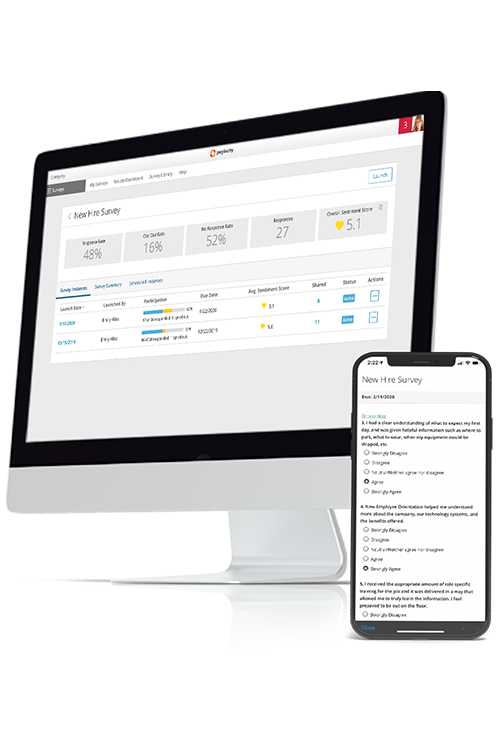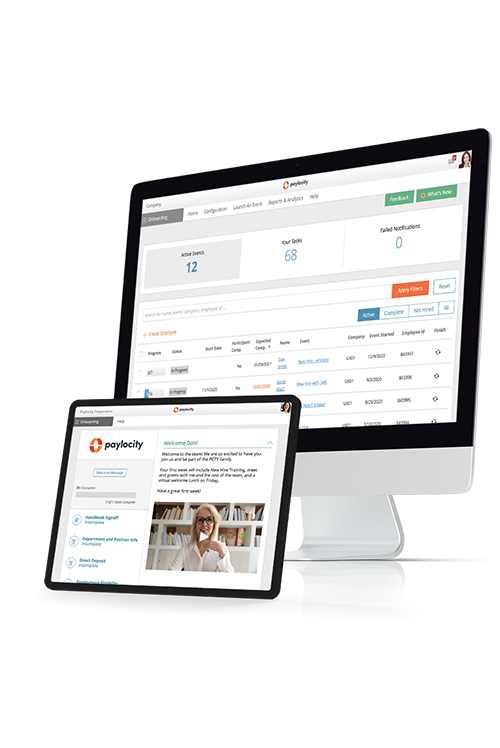
Navigating the AI Revolution in the Workforce: Insights, Reactions, and HR’s Role in Bridging the Gap
AI in the workplace is no longer a sci-fi fantasy — it’s here, it’s real, and it’s changing everything about how we work. Now, it’s up to HR teams to help employees embrace it, not fear it.
Just a few decades ago, the thought of artificial intelligence (AI) in the workplace conjured up a futuristic assembly line of robot workers handling tasks with mechanical precision.
Fast-forward to now, and the age of AI sort of looks like business as usual — still no robots in sight, just a whole stack of powerful new tools to play with.
But with AI evolving at warp speed, HR teams now face a mission-critical challenge: How to equip their workforce for a world where AI is a routine part of employees’ day-to-day.
Success in this new era requires HR teams to build trust and confidence in AI through clear communication, skill development, and open feedback.
Key Takeaways
- Business leaders and employees don’t currently see eye-to-eye on how AI will impact the workplace in the future.
- Prioritizing soft “human” skills such as adaptability, communication, and empathy alongside technical skills like data analysis and interpretation will equip employees with the right skill set to thrive in the AI era.
- Two-way feedback loops, including surveys, office hours, and internal messaging, will help HR teams stay on top.
The Current State of AI in the Workplace
The recent wave of AI-led workplace transformation may seem like it came from nowhere, but in reality, it’s been a long time coming. Recent technological advances in automation, machine learning, and conversational AI have made it more accessible than ever.
So, how are organizations using AI in the workplace? Its use cases are chameleonic and almost limitless: AI can become a customer service agent to answer quick queries, a data analyst to quickly crunch the numbers, or an HR coordinator to send personalized responses to interview candidates.
But AI’s increased integration into business processes comes with its own set of challenges when it comes to the workforce. Namely, it’s fundamentally changed how we work, the skills we need to perform our roles, and what jobs may look like in the future.
In simple terms: Toto, we’re not in Kansas anymore.
Global AI adoption has skyrocketed, with 2024 data from McKinsey finding that 72% of organizations have integrated the technology into at least one business process, compared to just 20% of businesses in 2017. Demand for AI skills (such as machine learning and automation) in job adverts shot up 3.5x between 2012 and 2023.
With early studies already highlighting its ability to boost worker productivity, leading to a downstream impact on profitability, it’s clear that AI has the potential to perform some tasks faster, better, and more accurately than humans.
However, achieving these outcomes and successfully integrating AI means organizations must shift their focus from the tech to their people.
Learn More: Two HR Technology Trends for 2024: From AI to EX
How Do Workers Feel About AI?
Despite AI’s promising potential, organizations face a huge gap between expectation and reality.
According to 2024 data from Gartner, 59% of CEOs believe AI will have the biggest impact on their business in the next three years. However, about a third expect it to deliver a more than 15% boost in worker productivity within the next two years.
But this optimism may be misplaced if organizations don’t focus on investing in the right processes and support to bring their employees along for the ride.
And that’s part of the problem — while employees clearly see the value of technology in making their day-to-day work faster and more efficient, they’re more cautious about its role in the future of work.
A 2024 Microsoft study found that 75% of employees bring their own AI tools to work, whether their organization has okayed their use of the tool or not. Meanwhile, our 2024 Employee Benefits and Tipping Study found that while 50% of employees are enthusiastic about AI’s ability to improve their work experience, 81% say they have reservations about their employer adopting the technology.
The concern at the top of the list? Job loss — a worry notably shared by frontline and Gen Z workers alike.
This reveals a critical disconnect: Business leaders are considering how they’ll use AI to drive greater productivity and revenue. But in a potential “job apocalypse,” workers are worried about a slightly more existential question: How will AI threaten their livelihood?
Broadly speaking, employee appetite for AI is there, but trust in the tooling and their organization’s motives for deploying the technology isn’t.
Bridging this gap means organizations must focus on building employee trust, cultivating understanding, and evolving skill sets to stay in lockstep with their AI strategy.
How HR Can Help Alleviate Employee Concerns on AI
AI is changing quickly. So, organizations must act fast to dispel the fear and support their employees in the next phase of work.
At baseline, this depends on helping employees understand what they’re working with — and how they can ramp up their skills fast to derive value from the tools.
But in the long term, as AI reshapes job roles, organizations need to clarify role progression and growth opportunities.
1. Drive Understanding with Transparent Communication
One of the biggest driving forces behind employees’ fear of AI centers around a lack of understanding of how the technology actually works, how your organization will implement it, and, ultimately, how it will impact their role.
Dispelling potential fears and misconceptions relies on upfront, transparent communication to help employees understand the what, when, how, and why — ideally, before implementing any tooling.
Creating an employee-facing FAQ will help address some of the most pressing questions. This should include:
- A simple, non-technical explanation of what AI is and what it can — and can’t — do.
- How and why your organization is planning to implement the technology.
- How AI will support your employees in their daily tasks.
- AI myths and misconceptions.
- Where to reach out for more information or support.
- How company and employee data will be protected.
2. Address Concerns Around Job Security
Job loss is top-of-mind for your workforce — and reassurance is critical to getting employees on board with AI adoption.
In the near term, acknowledge that roles, skills, and responsibilities will likely shift as AI embeds within your organization. This could lead to employees feeling that they no longer have the job they signed up for, so make sure line managers feel equipped to discuss this challenge and answer questions at a team level to identify any potential alternative pathways as needed.
In the longer term, HR must also clarify employee role progression, career paths, upskilling and reskilling, support, and growth plans. This will help employees envision their next steps and how their roles may develop alongside new technology.
3. Build Confidence with Technical Upskilling
AI’s entrance into the mainstream proves that you don’t need to be a computer scientist to use it. But to get the most from the technology, employees need the right practical skills to integrate it into their day-to-day work.
Data literacy and fluency are key. But instead of emphasizing complex skills like statistical analysis, focus on their practical application. Hands-on training with specific tools, such as large language models (LLMs) like ChatGPT, Microsoft Copilot, or Claude AI, will help.
At minimum, employees should know how to craft simple prompts to speed up research and writing. Beyond that, employees should learn how to connect AI in a context-specific way to their individual roles.
For instance, a finance team member can greatly improve their productivity and reduce monotony by learning how to use AI tools to automate data entry, detect errors, and analyze big datasets.
But remember that AI will continue to evolve, meaning your employees’ skills need to evolve alongside it. As such, organizations should focus on continuous multimedia training over the long term rather than one-and-done mass courses.
Learn More: AI in HR: From Efficiency to Employee Engagement
4. Strengthen Core Human Skills
In the battle of man versus machine, the things that make us human are our greatest power.
Our ability to empathize, reason, solve problems, and make decisions based on a nuanced context is something that AI can’t replicate — at least yet. Strengthening these skills will help employees integrate AI into their work more effectively and responsibly, viewing it as a collaborator rather than a competitor.
Three essential skills to nurture here include:
- Critical thinking: AI can often generate misleading or inaccurate data. Developing employees’ critical thinking skills will help them question and evaluate AI outputs and improve decision-making.
- Communication and relationship-building: Empathy, active listening, emotional intelligence, and conflict resolution will be critical skills in a logic-defined AI world — particularly for team management and customer-facing roles.
- Adaptability and agility: The current workplace is defined by change. Nurturing employee adaptability will be critical to navigating the rise of AI. Opportunities for continuous learning and cross-functional training will help employees adapt to new challenges, adopt and apply transferable skills, and build secondary expertise that matches the shifting needs of the business.
To foster these skills, tap into the power of cross-functional, peer-led learning. Lunch and learn sessions, mentorship programs, team projects, and group workshops provide a more engaging, practical format for cementing core skills.
5. Listen and Respond to Employee Feedback
AI is a technology as much as it is a transformative process. Embedding it long-term means organizations must continuously communicate this change to their workforce — but they also need to listen.
Create open feedback channels where employees can share their thoughts on AI and how it’s affecting their work. Regular employee engagement or pulse surveys will help HR teams keep an ear to the ground to detect emerging issues. Keep them anonymous so employees feel safe to share their true feelings.
Discuss issues openly in team and whole-company meetings. This will create greater transparency and provide the opportunity to crowdsource solutions among the workforce. Meanwhile, HR and senior leaders can also offer office hours if employees have individual concerns they’d like to raise privately.
Navigating the Future of Work: Empowering Human-AI Collaboration
The rise of AI taps into some very real, entirely human fears. After years of uncertainty, workers feel anxious about an unknown future in which the skills and experience they’ve carefully amassed over decades could be winked out instantly by a fancy computer.
Navigating this shift requires HR to address these challenges head-on by building the understanding, confidence, skills, and trust that centers AI as a way of working and an ally — rather than a tool or sideline process.
But if there’s one key thing HR needs to lean on as AI gathers steam, it’s employee feedback on how they’re managing the change.
Paylocity’s AI-enabled Employee Voice feature helps HR teams automate the feedback process at scale, analyze their insights in a snap, and dig deeper into employee sentiment to create a workplace where employees can thrive.
Want to learn more? Request a demo today!




